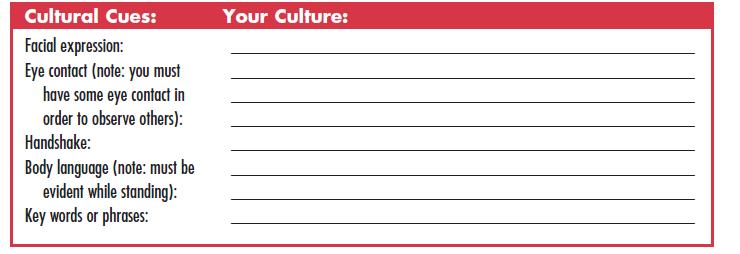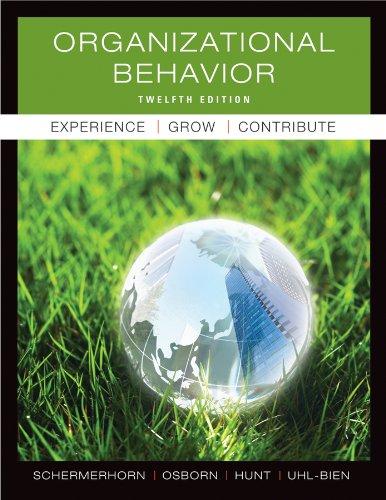In the business context, culture involves shared beliefs and expectations that govern the behavior of people. In
Question:
In the business context, culture involves shared beliefs and expectations that govern the behavior of people. In this exercise, foreign culture refers to a set of beliefs and expectations different from those of the participant’s home culture (which has been invented by the participants).
Procedure 1. (10–15 minutes) Divide into two groups, each with color-coded badges. For example, the blue group could receive blue Post-it notes and the yellow group could receive yellow Post-it notes. Print your first name in bold letters on the badge and wear it throughout the exercise.
Work with your group members to invent your own cultural cues. Think about the kinds of behaviors and words that will signify to all members that they belong together in one culture. For each category provided below, identify and record at least one important attribute for your culture.
Once you have identified desirable cultural aspects for your group, practice them. It is best to stand with your group and to engage one another in conversations involving two or three people at a time. Your aim in talking with one another is to learn as much as possible about each other —hobbies, interests, where you live, what your family is like, what courses you are taking, and so on, all the while practicing the behaviors and words on the previous page. It is not necessary for participants to answer questions of a personal nature truthfully. Invention is permissible because the conversation is only a means to the end of cultural observation. Your aim at this point is to become comfortable with the indicators of your particular culture. Practice until the indicators are second nature to you.
2. Now assume that you work for a business that has decided to explore the potential for doing business with companies in a different culture. You are to learn as much as possible about another culture. To do so, you will send from one to three representatives from your group on a “business trip” to the other culture. These representatives must, insofar as possible, behave in a manner that is consistent with your culture. At the same time, each representative must endeavor to learn as much as possible about the people in the other culture, while keeping eyes and ears open to cultural attri butes that will be useful in future negotiations with foreign businesses. (Note: At no time will it be considered ethical behavior for the representative to ask direct questions about the foreign culture’s attributes. These must be gleaned from firsthand experience.)
While your representatives are away, you will receive one or more exchange visitors from the other culture, who will engage in conversation as they attempt to learn more about your organizational culture. You must strictly adhere to the cultural aspects of your own culture while you converse with the visitors.
3. (5–10 minutes) All travelers return to your home cultures. As a group, discuss and record what you have learned about the foreign culture based on the exchange of visitors. This information will serve as the basis for orienting the next representatives who will make a business trip.
4. (5–10 minutes) Select one to three different group members to make another trip to the other culture to check out the assumptions your group has made about the other culture. This “checking out” process will consist of actually practicing the other culture’s cues to see whether they work.
5. (5–10 minutes) Once the traveler(s) have returned and reported on findings, as a group prepare to report to the class what you have learned about the other culture.
Step by Step Answer:

Organizational Behavior
ISBN: 9780470878200
12th Edition
Authors: John R. Schermerhorn, Mary Uhl-Bien, Richard N. Osborn





